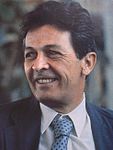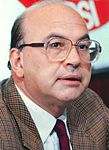Lombardy elected its ninth delegation to the Italian Senate on June 26, 1983.[1] This election was a part of national Italian general election of 1983 even if, according to the Italian Constitution, every senatorial challenge in each Region is a single and independent race.
| |||||||||||||||||||||||||||||||||||||||||
All 48 Lombard seats to the Italian Senate | |||||||||||||||||||||||||||||||||||||||||
|---|---|---|---|---|---|---|---|---|---|---|---|---|---|---|---|---|---|---|---|---|---|---|---|---|---|---|---|---|---|---|---|---|---|---|---|---|---|---|---|---|---|
| |||||||||||||||||||||||||||||||||||||||||
| |||||||||||||||||||||||||||||||||||||||||
The election was won by the centrist Christian Democracy, as it happened at national level. Six Lombard provinces gave a majority or at least a plurality to the winning party, while the agricultural Province of Pavia and Province of Mantua, and this time the industrial Province of Milan, preferred the Italian Communist Party.
Background
editAs the red rising seemed to be stopped in Italy, many center-right electors began to think no more necessary a vote for Christian Democracy which lost many seats to minor parties, especially to the Italian Republican Party of former Prime Minister Giovanni Spadolini.
Electoral system
editThe electoral system for the Senate was a strange hybrid which established a form of proportional representation into FPTP-like constituencies. A candidate needed a landslide victory of more than 65% of votes to obtain a direct mandate. All constituencies where this result was not reached entered into an at-large calculation based upon the D'Hondt method to distribute the seats between the parties, and candidates with the best percentages of suffrages inside their party list were elected.
Results
edit| Party | votes | votes (%) | seats | swing |
|---|---|---|---|---|
| Christian Democracy | 1,747,002 | 34.4 | 17 | 4 |
| Italian Communist Party | 1,447,823 | 28.5 | 15 | = |
| Italian Socialist Party | 615,644 | 12.1 | 6 | = |
| Italian Republican Party | 349,351 | 6.9 | 3 | 2 |
| Italian Social Movement | 255,667 | 5.0 | 2 | 1 |
| Italian Liberal Party | 197,084 | 3.9 | 2 | 1 |
| Italian Democratic Socialist Party | 192,172 | 3.8 | 2 | = |
| Radical Party | 103,697 | 2.0 | 1 | = |
| Others | 168,885 | 3.3 | - | = |
| Total parties | 5,076,325 | 100.0 | 48 | = |
Sources: Italian Ministry of the Interior
Constituencies
edit- No senator obtained a direct mandate. Please remember that the electoral system was, in the other cases, a form of proportional representation and not a FPTP race: so candidates winning with a simple plurality could have (and usually had) a candidate (usually a Christian democrat) with more votes in their constituency.
- ^ Linked to Spadolini's triple election.
Substitutions
edit- Maurizio Noci for Crema (13.6%) replaced Libero Della Briotta in 1985. Reason: death.
- Gian Pietro Rossi for Busto Arsizio (34.1%) replaced Pietro Padula in 1986. Reason: resignation.
- Felice Calcaterra for Monza (32.9%) replaced Gian Pietro Rossi in 1986. Reason: resignation.
- Italo Nicoletto for Salò (26.2%) replaced Giuliano Procacci in 1986. Reason: resignation.
Notes
edit- ^ Howard R. Penniman, “Italy at the Polls, 1983: A Study of the National Elections”
- ^ Incumbent MP Paolo Zanini helped his party running for this seat. However, according to the Italian Constitution, MPs can't be senators, so he ceded his senatorial seat to his party-mate Francesco Pintus.


